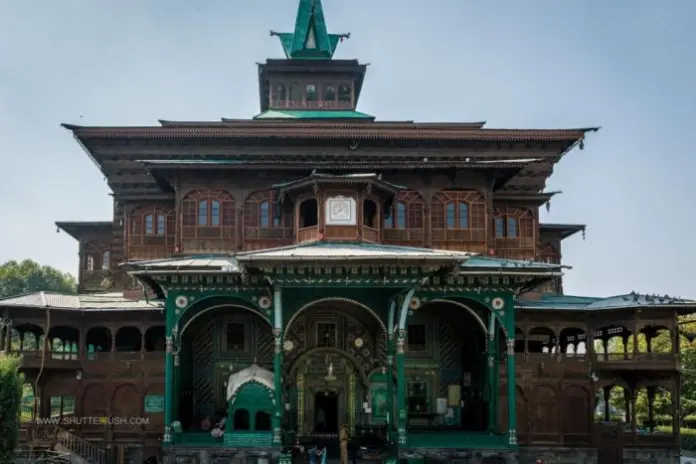By: Rayees Ahmad Kumar
Hazrat Amir Kabir Mir Syed Ali Hamdani (RA) often referred to as the founder of Islam in Kashmir came to the valley with a large group of comrades of Sayeds who were all Amirs and since he was their leader, so he is known as Amir-i- Kabir. Apart from the main mission of spreading Islam and inviting people to scrutinize the religion before accepting it, he is also regarded as having brought various crafts and industries to Kashmir, one among them being carpet weaving.
Born on 21st of October 1314 AD in a noble and pious family, his parents- Syed Shahabuddin and Syeda Fatima were the direct descendants of holy Prophet (Peace be upon him). His father was an administrator of Hamdan and his maternal uncle Syed Alluddin Simnani took the responsibility of his upbringing. Under his guidance Shah-i-Hamdan learnt and memorized the holy Quran.
An eminent scholar and Sufi of the time, Sheikh Sharfudin Mazdaqani initiated him into the Kubrawi order. He became his Murshid preceptor and involved with his religious, educational and spiritual upbringing. A brutal Tatar Zulchi invaded Kashmir in early 14th century AD, he and his companions created havoc for eight months and brought death, destruction and misery to the people. It is said that only eleven families survived in city. After his going back in 1320 AD, a Buddhist from Ladakh Rinchan Shah became the king of Kashmir.
During his reign Syed Sharfudin Abdul Rehman Suharwardi (RA) also known as Bulbul Shah from Turkistan came to Kashmir. It was through him that Rinchan Shah accepted Islam and was renamed as Sadruddin.
Before arriving in Kashmir, Shah-i-Hamdan sent his two followers, his cousins- Syed Tajuddin Simnani and Mir syed Hussain Simnani to valley to take stock of the situation. After this Shah-i-Hamdan made three visits to valley the first in 1372, when the ruling king Sultan Shahabuddin had gone on an expedition to Attock. The companions of shah-i-Hamdan who were less than hundred in number were received by Sultan Qutubuddin who later became his disciple. Shah-i-Hamdan stayed in the valley for six months following which he left for Makkah.
During his second visit in 1380, he was accompanied by 700 Syeds (descendants of the prophet’s family) who were warmly welcomed by Sultan Qutubuddin. This large group settled on the banks of river Jhelum near the present day Khanqah Moalla of Srinagar. That time the place was called Allaudin Pora. Shah-I-Hamdan and his disciples would offer prayers there, later the foundation of the Khanqah was laid there.
On this visit Shah-i-Hamdan stayed here for nearly thirty months, travelled across the length and breadth of valley, along with his companions, to propagate the true teachings of Islam. His third visit to Kashmir is recorded in 1384 AD, during which he fell ill after spending less than a year and left Kashmir for Turkistan via Ladakh. They stayed at Shey village of Leh, constructed a mosque there to worship making it the first Muslim site of worship in Ladakh. Traveling through the town of Pakhli, the party arrived at Kunnar, it’s king Khazar Shah pleaded him to stay for few days there as a royal guest.
He passed away on 19th January 1385 AD. Due to harsh winter weather his body was buried at Swat but in accordance with his wish, he was later laid to rest at Koulab on 4th of July 1385. His entire family is buried there.
Wherever Shah-I-Hamdan pay visit, he would invite people to Islamic and subsequently establish mosques and Khanqahs. Such Khanqahs were built in different parts of valley during his visit and the constructions were undertaken under the direction of his beloved son Mir Mohammad Hamdani.
Some of the famouse Khanqah’s in Kashmir valley include Khanqah Faizpanah Tral, Khanqahi Amirya Pampore, Khanqahi Walla Wachi, Khanqahi Amirya Monghama and Khanqah of Shey Ladakh near Leh. However the largest and most important one is the Khanqah-i-Moula of Srinagar and remains the most revered. It is not only the place of worship but also represents more than six hundred years of our heritage.
The architecture of the Khanqah is distinctively Central Asian with wood, sculpted stones and small bricks used as the building material. The foundation and the stone plinth of the Khanqah was laid by Shah-I-Hamdan himself while the task of building was undertaken by his beloved son Mir Mohammed Hamdani when he visited valley in 8th century AH during the reign of Sultan Sikandar. Its construction began in 1396 AD and was completed in 1399. The cooperation and generosity of Sultan Sikandar and Seh Butt were instrumental in the timely completion of the grand project. Mir Mohammed Hamdani came to Kashmir to continue the mission initiated by his pious father, the generosity and cooperation of the reigning king Sultan Sikandar helped him to extend a network of Khanqahs and mosques in each corner of valley.
The writer is a columnist based in Qazigund Kashmir. [email protected]








